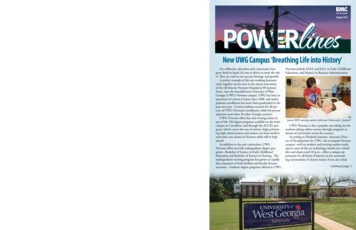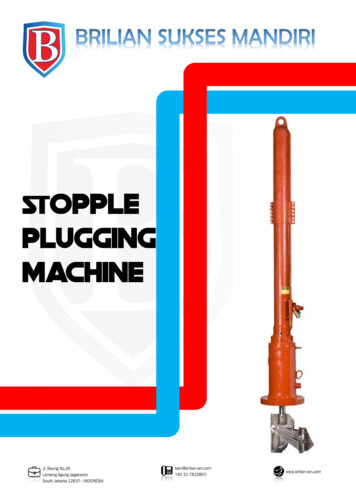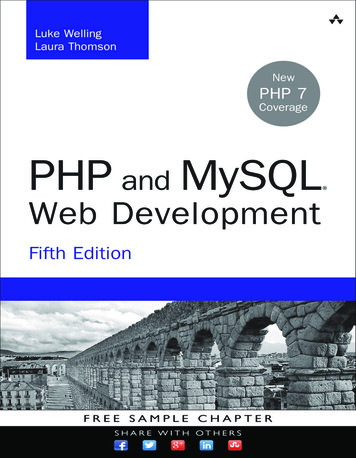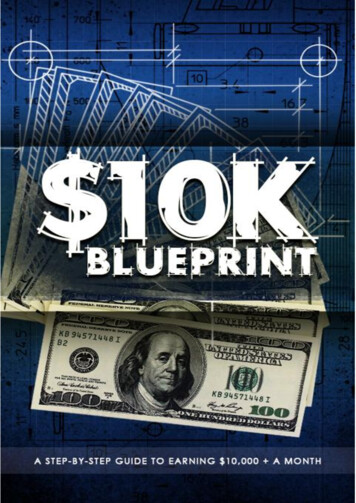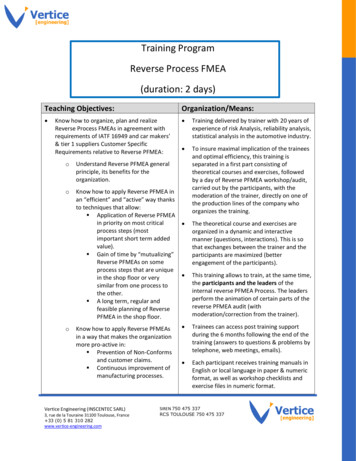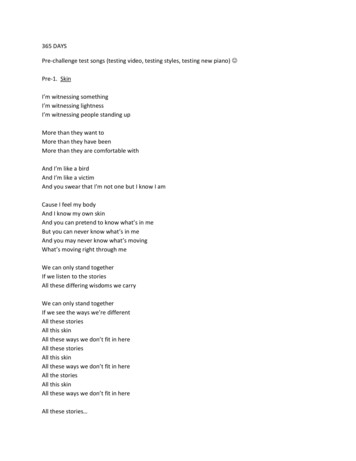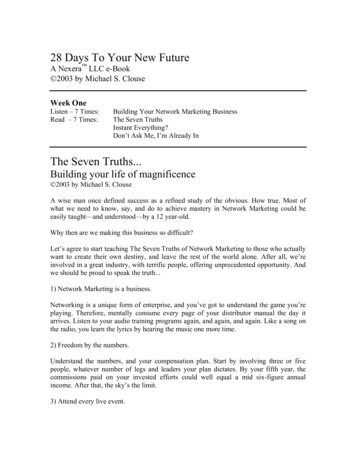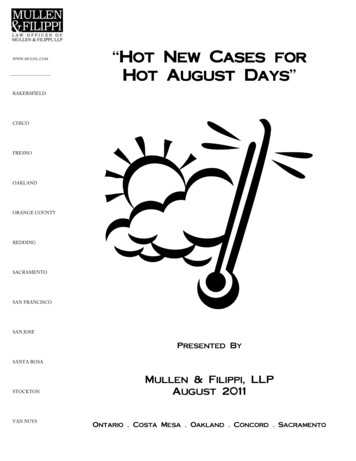
Transcription
WWW.MULFIL.COM“Hot New Cases forHot August Days”BAKERSFIELDCHICOFRESNOOAKLANDORANGE COUNTYREDDINGSACRAMENTOSAN FRANCISCOSAN JOSEPresented BySANTA ROSASTOCKTONVAN NUYSMullen & Filippi, LLPAugust 2011Ontario . Costa Mesa . Oakland . Concord . Sacramento
FIRST DISTRICT COURT OF APPEAL REJECTS WCAB’S FORMULAFOR REBUTTING DFEC COMPONENT OF THE 2005 PERMANENTDISABILITY RATING SCHEDULEOgilvie vs. WCAB;CA4th(July 29, 2011)Applicant was injured during the course of her work as a bus driver for theSan Francisco Muni. Using a strict AMA Guides Rating under the 2005Permanent Disability Rating Schedule (PDRS), applicant’s injury resulted in 28%permanent disability. However, applicant argued that the rating did not accuratelyreflect the true extent of her disability because it did not adequately consider herloss of earning capacity. (Both applicant and defendant retained vocationalrehabilitation experts who estimated the loss of earning capacity somewherebetween 51% and 53%.)The Workers' Compensation Judge agreed that the scheduled rating did notadequately compensate the applicant. Therefore, he found that the applicant hadrebutted the 2005 PDRS. The Workers' Compensation Judge awarded 40%permanent disability. The City petitioned for reconsideration.The Workers' Compensation Appeals Board granted reconsideration andissued an en banc decision in which it set out a formula that it believed was “basedon empirical data and findings” as required by Labor Code §4660. (The formulainvolved comparison of the applicant’s actual lost earnings with the wages ofsimilarly situated non-injured workers.)Both the City and Ogilvie sought review. The City alleging it was error toallow applicant to challenge the DFEC component of the schedule and Ogilviearguing that not only should she be allowed to challenge the DFEC, but the overallfinal permanent disability rating, as well.The First District Court of Appeal granted the petition and held that theWCAB overstepped its authority in devising a new formula for calculating DFEC.However, the Court stated that because the 2005 PDRS is considered“prima facie evidence” of an employee’s permanent disability, the schedule maybe rebutted. It then discussed three possible methods of rebuttal:1.The applicant may show a factual error in the application of theschedule (e.g. improper inclusion or exclusion of a factor ofdisability when applying the formula);Ogilvie vs. WCAB1
2.The applicant may challenge the data underlying the DFECadjustment factors formulated by the RAND Institute. (As anexample, the Court notes that there was no direct link between theinjury data used by RAND and the AMA Guides.)3.The Court also found that an applicant can show that an injury hasimpaired his or her rehabilitation, such that the future earningcapacity is diminished beyond what is reflected by the schedule.(This is essentially an application of LeBoeuf to show that thepermanent disability rating is inadequate.)The matter was remanded to the WCAB for further development of therecord consistent with these methods.Ogilvie vs. WCAB2
COST OF LIVING ADJUSTMENTS (COLA) TO PERMANENT TOTALDISABILITY OR LIFE PENSIONS APPLY ON THE JANUARY 1STAFTER THE INJURED WORKER FIRST BECOMES ENTITLED TOAND RECEIVES SUCH BENEFITBaker v. WCAB and X.S. (2011) Aug. 11 CA1/6 H0340401)In those cases wherein the injured worker is 100% disabled, the costof living adjustment (COLA) would apply on the January 1st aftersuch worker was deemed permanent and stationary;2)In such cases wherein the injured worker is awarded permanentdisability and a life pension, such worker is entitled to receive thecost of living adjustment (COLA) on the January 1st after thepermanent disability is exhausted and the life pension begins.Baker vs. WCAB3
TREATMENT OUTSIDE THE MPN IS NOT PERMITTED UNLESS THEEMPLOYEE HAS PRE-DESIGNATED A PRIMARY TREATINGPHYSICIANScudder vs. Verizon California, Inc. (ADJ 916063) (March 10, 2011)Applicant was employed as a cable splicer for defendant Verizon when hesustained injury to his left knee, low back and also suffered from deep veinthrombosis on February 14, 2006.Verizon had established a medical provider network (MPN). However, theapplicant had pre-designated a treating physician (Dr. Feldman) pursuant to LaborCode §4600(d). Therefore, he was not required to treat within the MPN.Dr. Feldman referred the applicant to a Dr. Johnson (non-MPN doctor),who then referred the applicant to two additional specialists (non-MPN doctors).The applicant (who was initially unrepresented) was also evaluated by aPanel QME. Following the PQME evaluation, applicant retained counsel and hisnew attorney designated Dr. Sobel as the primary treating physician. Dr. Sobelreferred the applicant to Dr. Lipper.At the trial, defendant challenged the admissibility of the reports from Drs.Sobel and Lipper.The Workers' Compensation Judge issued an Award in favor of theapplicant, and the Opinion on Decision stated that the Award was based on thereports of Drs. Sobel and Lipper.Defendant sought reconsideration, contending that only a pre-designatedphysician can refer an injured worker to another physician outside the MPN.A Board Panel granted reconsideration. The Panel noted that under Rule9780.1(c), an employee may treat outside an MPN if he or she had validly predesignated a treating physician. Pursuant to Rule 9780.1(d), a referral by the predesignated physician need not be within the MPN. Therefore, the initial treatmentby Dr. Feldman was valid, as were Dr. Feldman’s referrals to Dr. Johnson and theother non-MPN physicians.However, because Dr. Sobel was not a pre-designated physician or on theMPN, his treatment was not authorized, nor was his referral to Dr. Lipper.Therefore, their reports were inadmissible.Scudder vs. Verizon California, Inc.4
The matter was remanded with instructions to the Workers’ CompensationJudge to determine permanent disability without reliance on the inadmissiblereports.NOTE:Under the recent holding in Valdez vs. Warehouse Demo Services,the defendant should not be responsible for the cost of the treatmentor reports by the unauthorized, non-MPN physicians.Scudder vs. Verizon California, Inc.5
IF EMPLOYEE TREATS OUTSIDE A VALID MPN, REPORTS FROMTHE NON-MPN PHYSICIAN ARE INADMISSIBLE AND DEFENDANT ISNOT RESPONSIBLE FOR THE COSTS OF THE REPORT OR THETREATMENTElayne Valdez vs. Warehouse Demo Services 76 CCC 330(April 20, 2011; en banc)Applicant filed a claim for industrial injury occurring on October 7, 2009 toher back, right hip, neck, right ankle, right foot, right lower extremity, lumbarspine and bilateral knees while employed as a demonstrator for the defendant.Defendant accepted the claim and the applicant was properly notified of theemployer’s Medical Provider Network (MPN). She initially treated with aphysician from the MPN from October 9, 2009 to October 31, 2009. Thereafter,she began treating with a non-MPN physician to whom she was referred by herattorney.The matter went to trial on July 22, 2010 on the issues of temporarydisability and attorneys fees. Applicant relied on reports from the non-MPNphysician in support of her claim for temporary disability. Defendant objected tothe reports. The Workers' Compensation Judge overruled the objection, admittedthe reports and, in reliance on the physician’s findings, awarded applicanttemporary disability benefits for the period November 2, 2009 through February10, 2010.Defendant petitioned for reconsideration, contending that the reports of thenon-MPN physician were inadmissible and that the defendant was not liable forthe cost of the non-MPN treatment and reports. (Significantly, the applicant didnot file an Answer to the Petition for Reconsideration.)In its en banc decision, the WCAB discussed the Labor Code Sectionswhich allowed the establishment of MPNs and the notice requirements which adefendant must meet. When the defendant complies with all of the requirements, ifan applicant seeks treatment outside the MPN, the non-MPN physician cannot be theprimary treating physician and the reports from that physician are inadmissible.Further, citing Labor Code §4605 (“[n]othing contained in this chapter shall limit theright of the employee to provide, at his own expense, a consulting or any attendingphysician whom he desires [emphasis supplied]”), the Board found that thedefendant is not responsible for payment for either the treatment obtained outside theMPN or the reports of the non-MPN physician.Elayne Valdez vs. Warehouse Demo Services6
Applicant’s attorney has now filed his own Petition for Reconsiderationwhich is currently pending before the WCAB. Should that petition be denied, it islikely that applicant will petition for a Writ of Review in the Second District Court ofAppeal.In addition, counsel for the applicant in a separate case (Saldivar vs. AJBRanch) has filed his own Petition for Reconsideration in the Valdez case alleging thatthe Commissioners improperly “assume” that the defendant in Valdez hadestablished and properly noticed its MPN.Elayne Valdez vs. Warehouse Demo Services7
ALMARAZ/GUZMAN MAY BE USED TODECREASE WHOLE PERSON IMPAIRMENTRiley vs. City of Pasadena 39 CWCR 117 (2011)Applicant injured her right knee and claimed by compensable consequencean injury to the left knee, during the course of her employment as a Police Officerwith the City of Pasadena. The parties selected an Agreed Medical Examiner toevaluate the applicant’s injury under the AMA Guides. The doctor found injury toboth knees with impairment assessed at 37%.The left knee injury remained in dispute in light of no contemporaneousmedical evidence to support left knee symptoms following the right knee injury;applicant’s longstanding history of left knee injuries prior to this claim; priorrecommendations for a left knee replacement pre-dating the subject injury;applicant’s ability to perform all of her job duties without restrictions; and,applicant’s own testimony of no interference with the activities of daily living.In deposition, the Agreed Medical Evaluator acknowledged the inconsistencyin his rating when compared with the medical records and applicant’s deposition. Perthe Guides applicant would have no more than 7% whole person impairment. Partiesproceeded to trial on the nature and extent of injury and permanent disability.The trial judge awarded 15% permanent disability and found injury to the leftknee by way of compensable consequence. Defendant sought reconsideration, whichwas granted.The Workers' Compensation Appeals Board found the 15% permanentdisability rating was unsupported by the facts and there was lack of any evidence tosupport a left knee injury. The AME’s rating as to the 7% whole person impairmentwas adequately explained, supported by the evidence and, therefore, should havebeen followed.Accordingly, the Board amended the Findings of Fact to limit injury to theright knee only; defer the award of permanent disability, and returned the matter tothe trial level for a new permanent disability rating to the right knee which had totake into consideration apportionment for the prior awards.Riley vs. City of Pasadena8
WCAB AUTHORIZES PHYSICIAN’S “RATING BY ANALOGY”Laury vs. State Compensation Insurance Fund 39 CWCR 67 (2011)Applicant sustained accepted injury to his spine while lifting in the course ofhis employment as a cement mason. The injury also resulted in psychiatric disabilityand sexual dysfunction.The parties utilized an AME who found that applicant was permanent andstationary as of June 10, 2009. In his report, the doctor stated that “WPI wasdetermined both per the DRE and ROM method and the ROM yielded the higherresult. Also, note that I have analogized [applicant’s] sleep disturbance and sexualdysfunction which are a result of medications and pain ” The doctor stated thatrating by analogy “may be more in keeping with the actual impact on [applicant’s]ability to work. To do so, I refer the parties to figure 15-19 on page 427 [of theAMA Guides]” (which converts Whole Person Impairment into regional spineimpairment). The doctor notes that “this rating takes into account the methodallowed by the recent Almaraz/Guzman decision.”Following a trial, the Workers' Compensation Judge issued a Findings andAward which, among other things, found that the AME’s opinion had not rebuttedthe Whole Person Impairment aspect of the 2005 permanent disability ratingschedule. Applicant sought reconsideration which was granted.The Board found that the Workers' Compensation Judge should have reliedon the AME’s opinion and found that the WPI aspect of the 2005 permanentdisability rating schedule had been rebutted. Referring to the language inAlmaraz/Guzman, that when determining an injured employee’s Whole PersonImpairment, it is not permissible to go outside the four corners of the AMA Guides,the Board noted that a physician may use any chapter, table or method in the Guidesthat most accurately reflects the injured employee’s impairment and that figure 15-19is within the four corners of the Guides.The AME’s report noted that applicant had lost 60% of the use of his lumbarspine and that neither the DRE nor ROM method of rating fully reflected theapplicant’s level of work impairment. He then provided an alternate method usingfigure 15-19. The Panel concluded that use of that alternate method was appropriatetaking into consideration the doctor’s expertise as a physician and AME.Laury vs. State Compensation Insurance Fund9
SEPARATE RATING OF “GRIP LOSS” INAPPROPRIATE WHERETHERE IS NO EVIDENCE THAT APPLICANT’S IMPAIRMENT IS NOTADEQUATELY CONSIDERED IN RANGE OF MOTION TESTINGLopez vs. WCAB 76 CCC 180 (Writ Denied 2011)Applicant sustained injury to his left ring and little fingers when he hit asaw blade. Both the primary treating physician and Panel QME provided reports inwhich applicant’s Whole Person Impairment was based on loss of motion.When the matter went to trial, the Workers' Compensation Judge issuedrating instructions based on grip loss. Based on this instruction, the DEU Raterissued a Recommended Rating of 19% permanent disability. On crossexamination, the Rater testified that had she rated the decreased range of motiondescribed in the reports, the permanent disability would have been 7%. TheWorkers' Compensation Judge issued an award of 19% permanent disability andthe defendant sought reconsideration.The Workers' Compensation Appeals Board noted that the AMA Guides donot generally provide for impairment determinations based on grip strength testsbecause such measurements are subjective and may be influenced by the patient’sefforts. The Guides for the most part assess objective anatomic impairment. Inrare cases, grip strength may be used if the examiner believes that the loss of gripstrength represents an impairing factor that has not been adequately considered byother methods, such as a severe muscle tear. Impairment due to loss of strengthcould be combined with other impairments only if based on unrelated etiologic orpathomechanical causes. Decreased strength cannot be rated in the presence ofdecreased motion, painful conditions, deformities or absence of parts (i.e.amputations) that prevent effective application of maximal force in the regionbeing evaluated.While the Panel QME did provide grip loss measurements in his permanent andstationary report, there was nothing in the report to suggest that the range ofmotion method he used to rate the applicant did not adequately consider grip loss.Absent a finding by the QME that the applicant’s grip loss was not adequatelyconsidered in the range of motion testing and that there was impairment fromother unrelated etiologic or pathomechanical causes, the AMA Guides provide thatgrip loss is not an appropriate method for evaluating the applicant’s impairment.The WCAB granted defendant’s Petition and issued a new award of 7%based on the range of motion testing described in the Panel QME’s report.Lopez vs. WCAB10
Applicant filed a Petition for a Writ of Review, which was denied.NOTE:Other decisions under Almaraz/Guzman have allowed arating for grip loss. However, those cases involve a reportin which the doctor explained why, in his opinion, griploss provided a more accurate rating.Lopez vs. WCAB11
INSIGNIFICANT UNAUTHORIZED EX PARTE COMMUNICATIONWITH QME SHOULD NOT INVOKE REMEDY UNDERLABOR CODE §4063.2 (NEW PANEL QME)Alvarez vs. WCAB, 187 CA4th 575, 75 CCC 817 (2010)Applicants were the widower and 2 minor children of a waitress who diedfrom a cerebral hemorrhage and hypertension allegedly caused by heremployment. State Compensation Insurance Fund (SCIF) denied the claim.To resolve the AOE/COE issue, a Panel QME was appointed. He issued areport dated September 20, 2008.In order to obtain clarification on certain issues in the report, the doctor wasdeposed on December 4, 2008. He testified that certain medical records showed thatthe decedent suffered from a number of stressors in her personal life, includingallegations that her husband had sexually abused one of the children, resulting in thedecedent obtaining a restraining order. However, the doctor could not specify whichrecords contained this information. The parties agreed that the doctor would againreview the records and identify for them the records relied upon.The day following the deposition, the doctor telephoned defense counselstating that the medical file could not be located and requested another copy.Defense counsel then wrote to applicant’s attorney indicating that he hadreceived the call from the doctor and would be forwarding another copy of themedical file.Applicant’s attorney wrote back that defense counsel had “clearly violated theLabor Code by having an ex parte communication with the PQME”. He requestedthat the PQME report be stricken, that a new QME Panel issue and that sanctions andpenalties be imposed.At trial on the issues, defense counsel advised the Workers' CompensationJudge that the doctor had initiated the call, the nature of the call, that no substantiveissues were discussed and that he immediately advised opposing counsel of the call.The Workers' Compensation Judge found no improper communication.Applicant sought Reconsideration, which was denied. The Workers’Compensation Appeals Board found that while the call from the doctor was an exAlvarez vs. WCAB12
parte communication, it involved only administrative matters, rather thansubstantive issues.Applicant petitioned for a Writ of Review, which was granted in May 2010. TheCourt of Appeal stated that Labor Code §4062.3(e) prohibits ex partecommunications of any kind with the QME. It does not matter who initiated thecommunication. The Statute does not differentiate between “administrative” and“substantive” communications. The Court found that since there was an improperex parte communication, the remedy was exclusion of the QME’s report andissuance of a new Panel.Subsequently, in August 2010 defendant’s Petition for Rehearing was granted bythe Court of Appeal. At that time, the prior Decision was annulled and the matterremanded.The Court stated that that although Labor Code §4062.3 expressly prohibits exparte communications with the Panel QME, (except for an employee or deceasedemployee’s dependents in connection with the examination), because it isrecognized that there is a certain degree of informality in workers’ compensationproceedings, not every conceivable ex parte communication would permit a partyto obtain a new evaluation from a Panel QME. The Court stated that some exparte communications may be so “insignificant and inconsequential,” there wouldbe no resulting repercussion. The matter was remanded to the WCAB to reevaluate its conclusion based upon the principle involved and not based upon thedistinctions between the administrative versus substantive nature of thecommunication.Therefore, if an ex parte communication is deemed inconsequential, there wouldbe no consequences to contend with
Ogilvie vs. WCAB FIRST DISTRICT COURT OF APPEAL REJECTS WCAB’S FORMULA FOR REBUTTING DFEC COMPONENT OF THE 2005 PERMANENT DISABILITY RATING SCHEDULE Ogilvie vs. WCAB; CA4th (July 29, 2011) Applicant was injured during the course of her work as a bus driver for the San Franci
